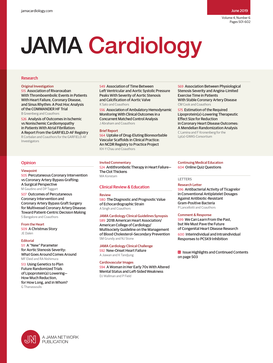流出道室性早搏消融术中的额外病变组:随机临床试验
IF 14.8
1区 医学
Q1 CARDIAC & CARDIOVASCULAR SYSTEMS
引用次数: 0
摘要
重要性流出道室性早搏(OT-PVC)消融术后复发仍是一个难题。尽管有时会在指数有效消融部位旁增加额外的病灶以加强消融效果,但这种方法是否有效仍不确定。本研究是一项多中心、前瞻性、随机临床试验。2021年10月至2023年2月期间,来自中国18家医院的首次接受导管消融术的OT-PVC患者被纳入研究。干预措施在确定靶点并通过单点消融消除PVC后,将患者按1:1随机分为额外消融组或对照组。主要结果和测量指标研究的主要终点是自基线至术后3个月期间PVC不再复发(PVC负荷减少≥80%,即24小时内PVC次数/24小时内总心跳次数×100%)。结果在308名参与研究的患者中,286名(平均[标码]年龄为49.2[14.6]岁;173名女性[60.5%])被随机分为额外消融组或对照组。额外消融组平均(标清)应用了 6.3(1.1)次射频,而对照组(单点消融组)平均(标清)应用了 1(0)次射频。中位(IQR)随访 3.2 (0) 个月后,额外消融组(142 例中有 139 例[97.9%])的 PVC 消失率明显高于对照组(139 例中有 115 例[82.7%];P < .001)。与对照组相比,额外消融组患者的 PVC 负荷减少幅度更大(平均 [SD] 减少幅度,23.0% [10.5%] vs 19.0% [10.4%];P = .002)。结论和相关性这项随机临床试验显示,与单点消融策略相比,额外消融在降低 OT-PVC 复发率方面具有优势,且不会增加并发症风险。在 OT-PVC 消融术中,应考虑在指数有效消融点周围进行额外消融:ChiCTR2200055340。本文章由计算机程序翻译,如有差异,请以英文原文为准。
Additional Lesion Sets in Ablation of Outflow Tract Premature Ventricular Contractions: A Randomized Clinical Trial.
Importance
Recurrence remains a challenge after ablation of outflow tract premature ventricular contractions (OT-PVCs). Although adding additional lesions next to the index effective ablation site is sometimes performed to reinforce the ablation, it remains uncertain whether this approach is effective.
Objective
To test the hypothesis that additional ablation lesions would reduce the recurrence rate compared with single-point ablation at the index effective site for the ablation of OT-PVCs.
Design, Setting, and Participants
This study was a multicenter, prospective, randomized clinical trial. Patients receiving their first catheter ablation for OT-PVCs were enrolled from 18 hospitals in China between October 2021 and February 2023. Scheduled follow-up duration was 3 months after the procedure.
Intervention
After identifying the target point and eliminating the PVC by a single-point ablation, patients were randomized 1:1 into an additional ablation group or a control group.
Main Outcomes and Measures
The primary end point of the study was freedom from PVC recurrence (≥80% reduction of PVC burden, which is the number of PVCs in 24 hours/total heartbeats in 24 hours × 100%) from baseline to 3 months postprocedure.
Results
Of 308 patients enrolled in the study, 286 (mean [SD] age, 49.2 [14.6] years; 173 female [60.5%]) were randomized to the additional ablation or the control group. The additional ablation group had a mean (SD) of 6.3 (1.1) radiofrequency applications, whereas the control group (single-point ablation group) had a mean (SD) of 1 (0) radiofrequency application. After a median (IQR) follow-up of 3.2 (0) months, the rate of freedom from PVCs was significantly higher in the additional ablation group (139 of 142 [97.9%]) compared with the control group (115 of 139 [82.7%]; P < .001). Patients in the additional ablation group also had a more substantial reduction in PVC burden than the control group (mean [SD] reduction, 23.0% [10.5%] vs 19.0% [10.4%]; P = .002). There were no severe periprocedural complications in either group.
Conclusions and Relevance
This randomized clinical trial showed a benefit of additional ablation in reducing the recurrence of OT-PVCs compared with the single-point ablation strategy, without increased complication risk. Additional ablations surrounding the index effective ablation point should be considered in OT-PVC ablation.
Trial Registration
Chinese Clinical Trials Registry Identifier: ChiCTR2200055340.
求助全文
通过发布文献求助,成功后即可免费获取论文全文。
去求助
来源期刊

JAMA cardiology
Medicine-Cardiology and Cardiovascular Medicine
CiteScore
45.80
自引率
1.70%
发文量
264
期刊介绍:
JAMA Cardiology, an international peer-reviewed journal, serves as the premier publication for clinical investigators, clinicians, and trainees in cardiovascular medicine worldwide. As a member of the JAMA Network, it aligns with a consortium of peer-reviewed general medical and specialty publications.
Published online weekly, every Wednesday, and in 12 print/online issues annually, JAMA Cardiology attracts over 4.3 million annual article views and downloads. Research articles become freely accessible online 12 months post-publication without any author fees. Moreover, the online version is readily accessible to institutions in developing countries through the World Health Organization's HINARI program.
Positioned at the intersection of clinical investigation, actionable clinical science, and clinical practice, JAMA Cardiology prioritizes traditional and evolving cardiovascular medicine, alongside evidence-based health policy. It places particular emphasis on health equity, especially when grounded in original science, as a top editorial priority.
 求助内容:
求助内容: 应助结果提醒方式:
应助结果提醒方式:


